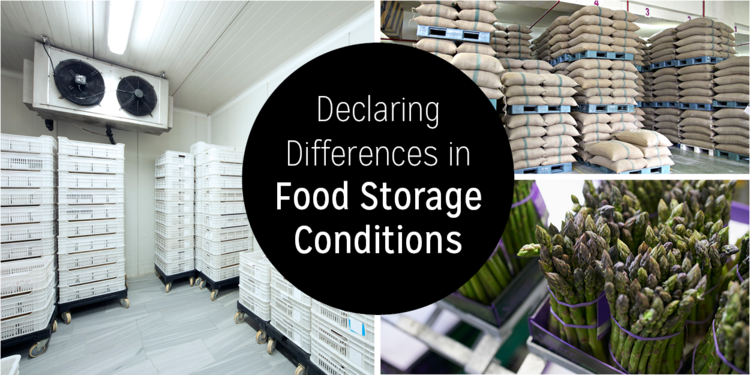Declaring Differences in Food Storage Conditions
Faulty food storage conditions that impact food safety can be difficult to detect early, but experts at AIB developed the Consolidated Standards for Inspection of Food Distribution Centers to assist in the prediction of these failures based on hidden patterns.
It is a complex topic involving a broad regulatory base, a diverse array of packaging, and many available storage choices. The overall goal: food safety must be retained at every level of the production chain to ensure that the consumer can safely enjoy the product. Five storage conditions that impact product safety are explained below.
Temperature Control
Refrigeration played a monumental role in the modern global trade of all food commodities. It is also one of the most widely practiced methods for controlling microbial growth in perishable foods. Increasingly due to FSMA, specific storage requirements for temperature-sensitive food products must be documented and routinely monitored. It’s a common practice that documentation may be achieved with a continual recording device or through manual measurements. Temperature control is vital especially if manual measurements are taken. The frequency of checks must be often enough to ensure that deviations from established temperatures are identified. Typically manual measurements are taken daily.
In regards to FSMA, exception records are also a method of documenting temperature control. A computer system monitors temperature and if it goes out of scope, an alarm is sent to management. This means calibration is an important process as well. All equipment used to monitor or document controls must be accurate.
Spacing
Adequate spacing remains a prime concern for food manufacturers. Food companies can spend millions of dollars to have enough available space in storage areas to prevent damage, improve efficiency, and comply with GMPs.
.jpg)
GMPs are requirements historically covered in 21 CFR 110. When the new FSMA regulation was created, the GMPs were updated and moved into 21 CFR 117 Current Good Manufacturing Practice, Hazard Analysis, and Risk-Based Preventive Controls for Human Food.
Market demand has heightened the importance of varieties so there can be a need to save space for seasonal products. Also, enough space is needed to keep materials away from walls in order to allow for pest inspections. As a result of this practice, it is recommended in dry areas to keep at least an 18-inch border between stored materials and the wall to facilitate cleaning and inspections. If this border is painted white or another light color, sanitation and pest issues are more easily identified.
“Spacing between individual pallets placed on the floor is also very important.” said Earl Arnold, Global Manager of Quality Assurance in Food Defense and FSMA for AIB. “Storing product for extended periods of time with limited space between pallets could lead to pest activity and we would not observe this until it’s too late. Conducting periodic inspections (minimum of every 4 weeks for products such as flour, sugar, or cereals) on these pallets and providing space can help prevent infestations.”
Segregation
.jpg)
Just as you keep fruits and vegetables separate and store like with like: apples with apples, carrots with carrots, the same segregation rules apply with any food storage. Food items should be segregated from nonfood items, such as chemicals, that are either used at the facility or distributed. Good manufacturing practices (GMPs) also require that chemicals should be separated or stored on lower sections of shelves and never above food products or packaging materials.
“One of FSMA’s biggest changes was the FDA created a new term -- allergen cross contact.” Arnold said. “The aim is to prevent allergens or allergen residue from transferring to products or equipment and then getting into products that do not have this allergen in it.”
This new term is mentioned 24 times in Subpart B of the new regulation. Additionally, the majority of recalls occur due to undeclared allergens. Segregating ingredients, finished product, labels, and packaging to prevent this is important.
Stock Rotation
Stock rotation is essential to ensure that materials are stored for the least amount of time. Here are two rotation methods used most often:
.png)
Ingredients are susceptible to insect infestation and should be a part of an inspection program that ensures they are inspected at least every four weeks. Four weeks is suggested because most product pests have a life cycle of 28 days. If you inspect every four weeks and identify insect activity you can take action and reduce the potential of other products from becoming affected.
Bulk Storage
By using a bulk storage system, facilities can look at the issues that need special attention. For example, liquid sugars should have a UV light system that controls microbiological hazards of concern in the headspace of the tank or silo. This UV light and ventilation system will need to be included in the preventive maintenance program. Flour silos also fall into this category.
.jpg)
“AIB’s Consolidated Standards for Inspection can be used by any kind of food facility, including distribution centers for bulk food, to identify conditions that need improvement in order to achieve a world class level of food safety for their products” said Cristina Bernal, Food Safety Professional, AIB. “The Standards can help a site develop the food safety prerequisite programs that need to be implemented to obtain, or maintain, a food safety program in compliance with regulations.”
AIB’s globally-recognized Consolidated Standards for Inspection are key requirements that facilities must meet to prove their products are wholesome and safe. AIB’s food safety professionals use these Standards as a guide for GMP Inspections.
The 2017 Food Distribution Centers Standard was released September 2016 and implemented for all inspections after January 1, 2017.


